-
After EPA fine, mining company building $200 million water treatment plant

America’s largest underground coal mining company, Consol Energy, is constructing a $200 million water treatment plant in West Virginia, after being fined $5.5 million by the Environmental Protection Agency (EPA); in 2009 discharge from Consol’s mining operation caused a toxic golden algae bloom that killed aquatic life along thirty miles of Dunkard Creek; the advanced waste water treatment plant will be the largest facility in Appalachia; the plant will be capable of treating 3,500 gallons of water per minute and will remove more than forty-three tons of dissolved solids, including eleven million pounds of chloride
-
-
Drought-prone pasts may foretell New York's and Atlanta's futures
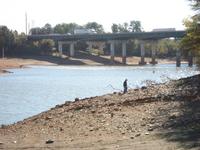
By fall 2007, during the second year of a three-year drought, Atlanta had roughly three months’ supply of water remaining while Athens, Georgia was down to approximately fifty days; another drought dramatically lowered New York City reservoirs to 33 percent of capacity in 1981; droughts in those cities and their surrounding regions were typically longer and more frequent centuries ago than they were for most of the twentieth century; a return to historic climate patterns would bring more frequent and prolonged droughts
-
-
U.S. reconsiders nuclear plant sites amid safety review
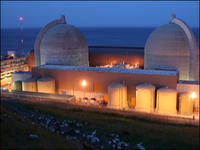
Following the nuclear crisis that occurred in Japan as a result of a massive earthquake and tsunami, the United States is undergoing a thorough safety review of existing plants that may affect where new plants are located; President Obama ordered the Nuclear Regulatory Commission (NRC) to conduct a comprehensive safety review of all nuclear plants in the United States; observers are particularly concerned with the Indian Point nuclear power station located forty miles north of New York City; if an accident were to occur, up to twenty million people, including eight million in New York City, would have to be evacuated
-
-
Lodi, CA considers privatizing $36 million water plant
The city of Lodi, California is in the midst of building a new $36 million water treatment plant, and is considering privatizing the facility; the new plant will open in 2012 and provide the city with one-third of its drinking water; Lodi is in a tight financial situation and is considering methods to reduce costs like privatizing the new treatment plant; the treatment facility is expected to cost $1.8 million to operate annually with an additional $1 million for payroll; Lodi residents have proposed that the city hire a private company to save money on payroll
-
-
Politics stalls $250 million water plant in North Vegas
A $250 million wastewater treatment plant in North Las Vegas suffered a major setback after county commissioners denied the plant’s request to use county land; the city had planned to route treated water through unincorporated county territory and pay the county $50,000 a year, but the county voted six to one against the plan; county commissioners say that the city has not been cooperative; commissioners were particularly upset about the city’s lucrative deal with Nellis Air Force Base that would take $1.25 million in revenues from the county each year; the plant has been under construction for years and needed the use of a Clark County pipeline to operate
-
-
Sector Report for Monday, 21 March 2011: Infrastructure protection
This report contains the following stories.
Plus 2 additional stories
-
-
New reactor design lessens risks
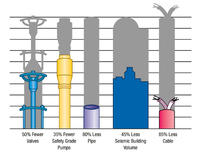
One of the major vulnerabilities of the four Japanese reactors which failed as a result of the combined force of the earthquake and tsunami, was that they relied on active cooling systems that require electricity; if there is a power outage, and if diesel back-up generators stop working, water stops flowing into the reactor pool to keep the uranium rods cool; newer reactor design relies on a passive cooling system: water is suspended over the reactor housing, and if pressure within the system drops, this allows the water to fall into the reactor area, submerging it in enough water to keep it cool
-
-
U.S. most vulnerable reactor: Indian Point 3, N.Y.
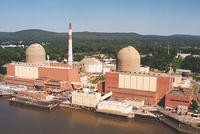
What are the odds that a nuclear emergency like the one at Fukushima Dai-ichi could happen in the United States? Tasked with ensuring nuclear power is safely used, the U.S. Nuclear Regulatory Commission (NRC) has compiled a ranking of 104 nuclear reactors to address such a question and they have found that each year, at a typical U.S. nuclear reactor, there is a 1 in 74,176 chance that an earthquake could damage the core and expose the public to radiation
-
-
Germany ends nuclear program
Last Thursday German chancellor Angela Merkel declared that her government plans to close its nuclear power plants in a “measured exit”; the decision to end Germany’s nuclear power program was a result of the continuing nuclear crisis in Japan; some believe that Chancellor Merkel’s announcement is driven more by politics than safety concerns; recent polls show that 80 percent of voters are opposed to nuclear power; Merkel’s party faces close regional elections in states where nuclear plants are located; Switzerland, Venezuela, and China have also announced that they will suspend or delay plans to build new nuclear plants
-
-
U.S. nuclear program under greater scrutiny
The ongoing nuclear crisis in Japan has caused countries around the world to reconsider its nuclear plans; Germany recently announced that it was ending its nuclear program, while Sweden, Venezuela, and China have all announced that they were temporarily suspending their nuclear programs to conduct safety reviews; lawmakers and engineers in the United States are also pushing for greater scrutiny of nuclear power plants; in its latest report the Union of Concerned Scientists sharply criticized the U.S. Nuclear Regulatory Commission (NRC) for not properly enforcing safety regulations at nuclear power plants;
-
-
Senate proposes new $10 billion "infrastructure bank"
Several U.S. Senators are pushing for the creation of a $10 billion “infrastructure bank” to spur investment in new infrastructure and to repair America’s rapidly aging roads, power grids, and bridges; the bill could attract as much as $640 billion in private investment over the next ten years; the Obama administration has proposed a similar plan; the bank would be self-sustaining as it is not allowed to finance more than 50 percent of a project’s costs; this bill faces an uncertain future given the current Congressional budget climate
-
-
Oregon declares state of emergency to repair damaged ports
The 11 March tsunami born of Japan’s 8.9 magnitude quake battered U.S. coasts and ports from Hawaii and the Pacific Northwest to southern California; the governor’s office in Hawaii expects damages to run about $10 million with estimates heading toward $50 million in California; one county in Oregon is reporting $25 million worth of destruction in one of three damaged ports
-
-
Oil industry creates center for off-shore safety
Following several accidents on off-shore oil rigs, the U.S. oil and gas industry will launch a center dedicated to investigating safety issues related to off-shore drilling; the center will be operated by the American Petroleum Institute (API) but will be walled off from the trade group’s lobbying work
-
-
Nuclear crisis worsening; growing radiation leaks at reactors nos. 3, 4
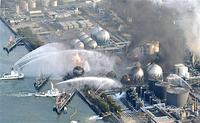
The situation at the Fukushima Daiichi nuclear power plant appears increasingly dire, as efforts to cool overheating reactors have failed; Japanese military fire trucks are now spraying water at the plant’s no. 3 reactor; earlier efforts on Thursday to use helicopters to dump water on the rods have failed; the U.S. Nuclear Regulatory Commission chairman is particularly concerned about reactor no. 4 which houses spent fuel rods; spent fuel rods, placed in cooling tanks, are rapidly overheating as they are boiling away the water they are submerged in; the secondary containment unit at reactor no. 4 has been breached and radiation is now freely leaking out of the plant; high radiation levels are hindering efforts to repair the reactors
-
-
Cable connected to reactor no. 2, coolant pumps to be restarted
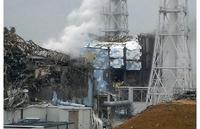
Tepco, the operator of the stricken reactors, says — and the IAEA confirms — that its engineers have been able to reconnect a power line to reactor no. 2; the 1-km cable connects to the main power grid; restoring power should enable engineers to restart the pumps which send coolant over the reactor and into the pools where radioactive waste is stored; Tepco said the process of reconnecting power could take up to fifteen hours; senior IAEA official Andrew Graham said the situation at Fukushima had not deteriorated, but could yet do so. He described the situation at “reasonably stable”; the head of the IAEA, Yukiya Amano, is heading to Tokyo to be briefed by Japanese officials
-
More headlines
The long view
Helping Strengthen America’s Critical Infrastructure
Everyday life depends on a robust infrastructure network that provides access to running water, communications technology and electricity, among other basic necessities. The experts who keep our national infrastructure secure and resilient also need a strong network to share their knowledge and train the next generation of professionals capable of solving complex infrastructure challenges.
AI and the Future of the U.S. Electric Grid
Despite its age, the U.S. electric grid remains one of the great workhorses of modern life. Whether it can maintain that performance over the next few years may determine how well the U.S. competes in an AI-driven world.
Using Liquid Air for Grid-Scale Energy Storage
New research finds liquid air energy storage could be the lowest-cost option for ensuring a continuous power supply on a future grid dominated by carbon-free but intermittent sources of electricity.
Enhanced Geothermal Systems: A Promising Source of Round-the-Clock Energy
With its capacity to provide 24/7 power, many are warming up to the prospect of geothermal energy. Scientists are currently working to advance human-made reservoirs in Earth’s deep subsurface to stimulate the activity that exists within natural geothermal systems.
Experts Discuss Geothermal Potential
Geothermal energy harnesses the heat from within Earth—the term comes from the Greek words geo (earth) and therme (heat). It is an energy source that has the potential to power all our energy needs for billions of years.
